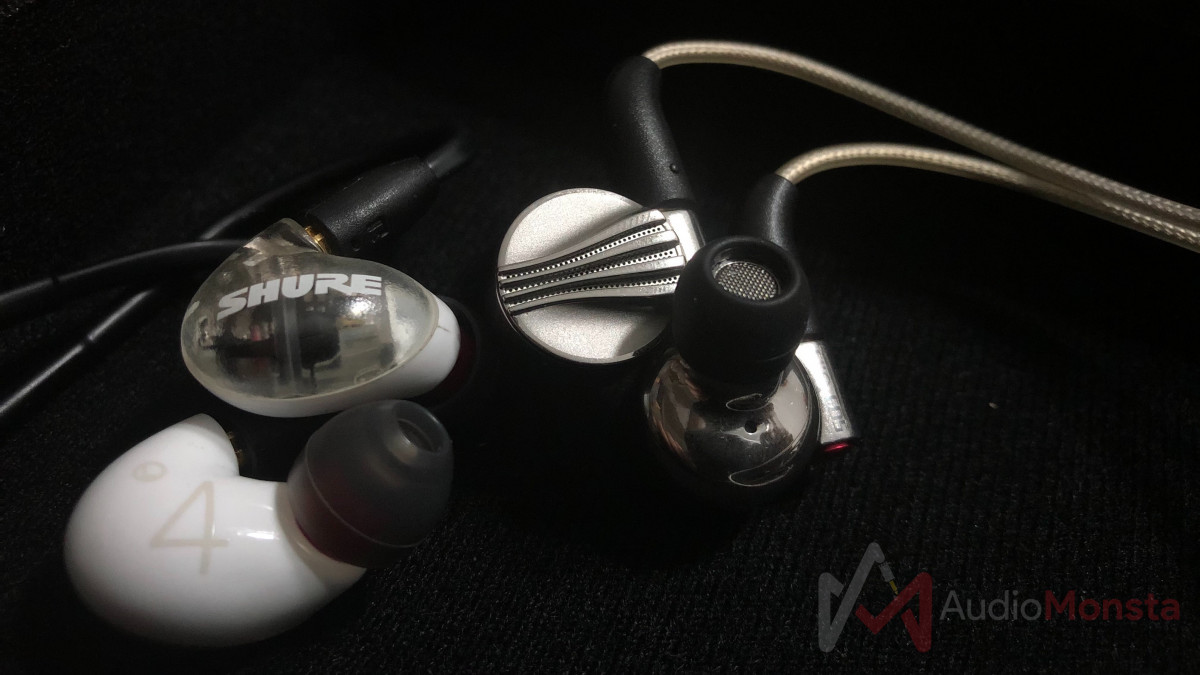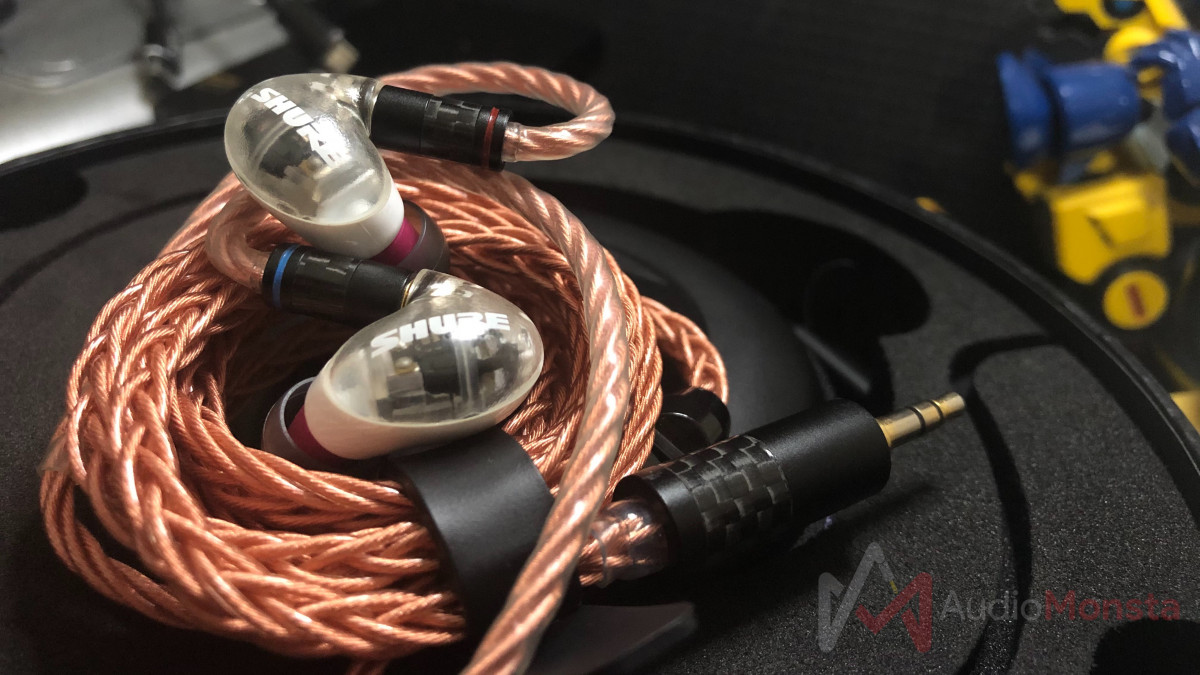Intro
Amidst the sea of what seems to be the never ending Chi-Fi iems flooding into the audiophile market, I personally began to wonder how the western’s giant names in audio equipments are holding up. One in particular is Shure.
Shure brand name is almost a household for many professional setups in which piqued my interest on what their latest iem line-up can offer. Here I will be sharing my opinion and thoughts on Shure’s Aonic 4, one of the recently launched hybrid driver mid-tier iem to refresh their offerings.
There never was a hybrid iem released by Shure and this Aonic 4 is the first hybrid iem from this industry giant sporting a single micro-dynamic driver and a balanced armature (details not specified). How do they fare? Is their newly ventured hybrid configuration any good? Read on…

Packaging
The box reminds me of Kinera’s offerings, only that those are hexagonal and these are round in shape. Quite big and very well done (a very much welcomed improvement) as compared to their previous line-ups. Top side of the box sports the image of the actual iem while the bottom side lies all the relevant specs for the curious.
It’s a 2-piece lift up box similar to most smartphone boxes nowadays where inside, the user manual greet its innocent new owner. Underneath the manual, a round carrying case along with the actual iem nestles within the top halve of the foam inserts while the bottom halve lies the accessories. A simple yet effective presentation indeed.
Shure is surely being generous with their out-of-the-box eartips selection. Included inside the box are the usual Olives, some foams and a silicon tri-flange eartips. They do also include a cleaning tool for…well…you’ll know when to use them in time.
Overall, Shure really did improve on the product presentation. But does the line-up “refresh” ends here? Not quite yet!

Functions & Specifications
- Material – Plastic
- Transducer Type – 1 Micro-Dynamic Driver, 1 Balanced Armature
- Sensitivity – 106dB SPL/mW @ 1kHz
- Impedance – 7ohms @ 1kHz
- Frequency Range – 20Hz to 19kHz
- Weight – 21.1g
What’s in The Box
- Shure Aonic 4
- Round Carry Case
- Cleaning tool
- 6.35mm to 3.5mm adapter
- Shure Olive eartips (S, M, L) x 1 pair each
- Shure Foam eartips x 3 pairs
- Shure Yellow Foam eartips x 1 pair
- Shure Triple Flange eartips x 1 pair

Retail Price & Where To Get
RM1,271.60 @ Concept Audio (KL)
Sound & Tone Presentation
The Aonic 4 presents the sound in a warm and polite manner. Tuned to carry a mild V-shaped signature across the frequency range, these gives you a relaxing and immersive experience where you can get carried away (might bore you to sleep) in your music. Quite laid back for my taste but always a welcome addition to switch the mood every once in a while.
*As usual, tip rolling usually helps compensating the sound character to cater more to your own liking. I’ve found that using Spinfits CP800 tames down the sibilant quite a bit at the expense of some shimmer on the top end. Normally I don’t prefer the foams as they tend to veil the sound too much for my liking.
Source Used
Hiby R2 > iFi micro iDSD Black Label > Shure Aonic 4
Hiby R2 > Topping NX4 DSD > Shure Aonic 4
Songs Used (16bit @ 44.1kHz flac)
- Ratatat – Bilar
- 2Cellos – Celloverse
- Ella – Sepi Sekuntum Mawar Merah
- Misha Omar – Nafas Cahaya
- Wings – Taman Rashidah Utama
- Lefthanded – Debunga Wangi

Bass
Bass on the Aonic 4 while being much present, they’re not the deepest sub-bass around. The much liked dynamic driver rumble is also considerably absent here, just a good clean sub-bass presentation. Mid-bass is slightly more dominant with its thumpy and well rounded presentation. While lacking in impact, they’re more likely to give a grin to your face with its polished texture. Despite not having fast decay, they’re by no means slow to the extend of clouding the lower mids but more of a natural-slow decay which adds some body to the overall signature.
Mids
The mild V-shaped signature definitely renders the mids to be slightly recessed, but far from sounding muddy nor veiled on the lower-mids. They are considerably clean for a hybrid configuration which should be no surprise by current standards. One could only expect it to be cleaner with a better tuned, mids focused hybrid or full BA driver *coughs (or even planar) configurations. With the considerably clean mids, detail retrievals are enough to be enjoyed. It’s by no means dissecting the mids section through and through, but enough to keep you seated and keep on listening. The upper-mids are very enjoyable without being shouty nor thin sounding but definitely missing the exciting engagement within this range every now and then.
Treble
Despite Shure’s target market for the mass consumer, the treble on the Aonic 4 can be annoyingly sibilant, especially with their stock olive eartips (YMMV). Upper treble lacks airiness which is a bummer for those who are hooked with the excitement that are offered in that particular region. Nuances are there but almost indiscernible to the extent of being almost dark sounding. Considerably early rolled off treble made the Aonic 4 sounds boring to say the least. But for the price and the intended target market, I don’t quite see it as a flaw but rather a starting point before plunging into the rabbit hole (albeit at quite a premium price).
Timbre & Tonality
Shure managed to tune the Aonic 4 to be a pretty well done cohesive sounding hybrid iem with a natural, slightly warm and laid back sound character.
Soundstage
I have high expectations on the technicalities department coming from western companies’ iem and for a start, the soundstage on the Aonic 4 is wonderfully holographic. They presents the sound in a very decently sized, average width and depth with good amount of height impression all around the soundscape. While not being large (slightly above average to be honest), they are somewhat spherical, which leads to the immersive experience while listening to them.
Imaging & Separation
The Aonic 4 shows an excellent imaging thanks to their holographic soundstage. Not pinpoint accurate but still very much worthy of its price tag. Along with the imaging prowess, separation between instruments are also great. One can distinguish every instrument easily accompanied with good but not quite spectacular layering ability. They are by no means a slouch in layering department though, just don’t expect them to compete hand in hand with a very well done multi-BA or hybrids configurations.
Driveability
Rated at 7 ohms, 106dB SPL/mW @ 1kHz, these are very efficient and as friendly as they can get with any source imaginable. Heck they even came with a mic provided to be readily usable with mobile phones. No arguments here, really.
Synergy
The Aonic 4 manage to retain most of its signature with subtle changes with regards to the DAC being used. Alas, these would pair very well with neutral sounding sources.
Comparison
FiiO FD5 (on wide bore nozzles)
I was genuinely impressed with FiiO’s flagship Beryllium coated single dynamic driver. FD5 sounds grander (read: lush), more energetic and engaging as compared to the Aonic 4. Bass on FD5 sounds fuller with deeper extension between the two. Mids are weightier and a bit fuzzier in comparison (don’t get me wrong, they have superbly tuned clean mids) which adds some character to the sound presentation of the FD5. Treble is a tiny bit hotter (but well controlled), more extended, much more airier and more engaging on the FD5. Timbre is almost identical for both but the FD5 is ultimately the more natural sounding iem.
As written on my dedicated review, the detail retrieval is great on the FD5 but the Aonic 4 does this a smidgen better to say the least. Subtle nuances are in a more polished presentation as compared to the FD5. The Aonic 4 presents the soundstage in a more spherical manner while the FD5 being slightly wider than deep, and much bigger in comparison. Imaging is slightly more precise on the Aonic 4 but the FD5 shows excellent separation between instruments. Layering capability is better on the FD5 thanks to the huge soundstage.
When it comes to build quality and packaging, there’s no competition here. FiiO’s offering is much more premium than that of Shure’s. The unboxing experience of the Aonic 4 is honestly disappointing in comparison. But the Aonic 4 do make it up on sound and technical capabilities giving the FD5 a run for its money. In my opinion, these two iems complement each other to say the least. Despite having different driver configurations, ultimately it’s how they deliver the sound that will make or break the purchase decision.

Worthy mention
FiiO FH1
Upon first listen to the Aonic 4, it reminded me of the now discontinued FiiO FH1. So I took the liberty to revisit the iem just to see if I was right. But I was wrong. The V-shaped signature is more prominent on the FH1 with deeper bass extension, slightly more elevated mid-bass, slight forward upper-mids, higher tendency towards sibilant but with better treble articulation. The Aonic 4 is everything on the FH1 but much more refined and provide a better non-fatiguing listening experience.
On technicalities, the Aonic 4 trumps the FH1 in every way imaginable especially with that bigger and holographic soundstage and an overall better imaging, separation and layering capability. Well, this was an unfair comparison to begin with despite having the same driver configuration. But why did I bother to include this iem? Because Chi-Fi companies seem to give the best value:performance ratio on their products line-up (YMMV).

For Who?
Mobile phone users whom mostly stream their music or mass consumer who enjoys an immersive, relaxing listening experience without the need of preposterous audiophile setups. Another group of people that might be keen are those who wants to purchase a product from a well reputable brand with great customer service and worry less about product quality control as normally seen plaguing the Chi-Fi scene (where hit or miss is the staple gamble). Not to mention for audiophiles who are always on the move and preferred a laid back sound signature.
Verdict & Stars
With other great options coming from the Eastern companies around the same price bracket, it’s hard to actually recommend the Shure’s Aonic 4 (at least to audiophiles). The sound is somewhat subdued throughout the frequency range giving you a laid back listening experience (even almost dark sounding) but most definitely better tuned to cater for the mass consumers and casual listeners alike.
Improvement from their SE215? Definitely. How about the SE425? Those sounded a bit artificial while the Aonic 4 is much more natural sounding thanks to the hybrid configuration. Add that with the already well known bean shaped iem comfort, excellent passive noise isolation and easily driven drivers, there you have it; an iem that is pleasing to the ears but far from being a slouch in the technicalities department. All in all, a well done first hybrid configuration iem attempt.
 (5 / 5)
(5 / 5)









